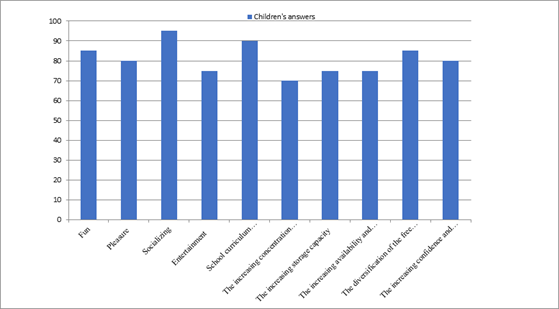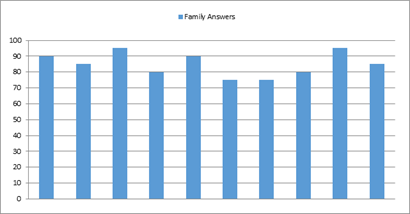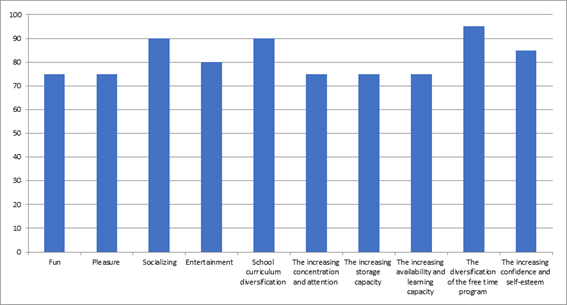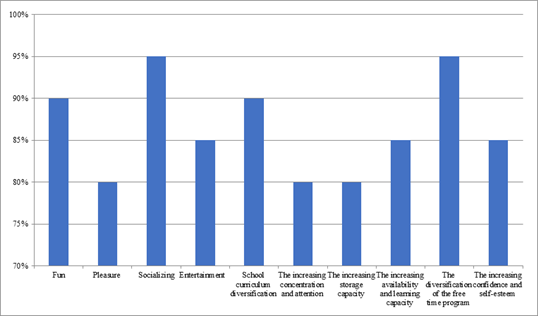Abstract
The implementation of the multimedia training programs comprises simple activities, easy to remember, which have proven their effectiveness in pupils’ training. These cognitive activity breaks have limited duration of 2-5 minute and they can be specifically designed to be implemented in schools. The development of psychomotor skills holds an important place in the therapeutic education if we take into account that mental deficiency is generally associated with functional deficiencies too. The aim of this study is to investigate the effects of our designed intervention based on multimedia methods to promote physical exercises with duration of 5 minutes. Starting from the curriculum content, we wanted to implement physical activities during classes, organized so that it will influence children’s behaviour, effort capacity, as well as social integration and academic performance. We conducted a pilot study with a group of 15 pupils with the age between 11-14 years old, integrated in a special education program school. Specific assessments of growth and physical development were directed towards the identification of their current psychomotor level. As results, after the implementation of brain breaks we can mention: increased motivation to participate in non-formal learning activities, the development of children’s physical, cognitive and social potential and access to information for pupils with dyslexia, taking into account the varied possibilities of the multimedia programs. In conclusion, our proposed model of intervention can represent also a model of good practice for the local community and the specialists in different professions related to health and quality of life promotion.
Keywords: Motivationexercisesmultimedia platformintellectual disorder
Introduction
The quality of life and well-being of children with intellectual disabilities are framework objectives of school and extra-curricular activities for today's society (Mura et al., 2015; Ahamed et al., 2007).
The way to increase the adaptive performance of the children are studied and promoted through a series of printer programs that include physical therapy and motion prophylaxis (Chin, Edginton, & Tang, 2012; Donnelly et al., 2016). The learning activity is planned and organized in accordance with the pupils' special educational requirements (Dobbins, Husson, Decorby, & Larocca, 2013). It includes specific assessment strategies for each projected endpoint and performance level monitoring (Srikanth et al., 2015).
Disability is the term used by the World Health Organization (WHO) to define impairments, activity limitations, and participation restrictions caused by a health condition (impairment / chronic illness (Hillman, Erickson, & Hatfield, 2017). The number of people with intellectual disabilities has grown in the entire world and in our country every year (HOPSports, 2014).
Problem Statement
According to the specialized literature, the level of physical activity for children is at least 60 minutes per day with heart rate training up to 150-160 beats per minute, which implies a moderate or intense physical effort (Mok et al., 2007).
Assessing your health is important in setting your physical effort program (González et al. 2016). This requires, according to the evaluation sheet applied in children with intellectual disabilities’ physical therapy, the evaluation of physical / sensory skills by tracking the straight line, on rough terrain, at the stairs, monitoring the working position (standing, sitting, squatting, asymmetrical positions, decubitus etc.), global skills (force, symmetry, coordination of body movements or segments, degree of symmetry etc.), evaluation of functional balances (joint amplitude, strength, muscle tone) (Hillman et al., 2017).
Research Questions
In order to establish the inclusion criteria in the study group, evaluation scales and specific tests were used, starting from the knowledge and exclusion of the contraindications for effort in the current legislation (the family’s doctor’s note, severe bronchial asthma with the last crisis dated 6 months ago maximum, cardiovascular diseases such as angina pectoris, extreme tachycardia or bradycardia, mitral valve prolapse, endocrine obesity, autoimmune diseases, blood diseases such as anaemia, thalassemia with splenomegaly, psychiatric disorders - extreme anxiety, apathy of psychomotor excitation, etc.
In order to start the research, it is necessary to promote a climate of confidence and to provide security conditions for preventing injuries and triggering episodes of anxiety or aggression / irritability, eventual emotional imbalances; establishing the ability to understand, integrate and socialize, availability for effort or play; ensuring a safe climate, tactful confidence and respect for confidentiality; not least the provision of technical conditions, specific endowments, access to the equipment and the possibilities for evaluation and monitoring of the children.
Purpose of the Study
The target group was represented by 15 children with minor and moderate intellectual disabilities. The physical exercise program was built using the Hop Sport platform. Physical exercises are performed with musical support, the level of difficulty is minimal, the intensity of effort is medium and high, the duration is maximum 5 minutes; what is interesting, and the novelty element is to use a varied background, adapted to children’s physical and educational needs. This stimulates the capacity to memorize the movements, stimulates the sensory or immediate memory with impact on the short or temporary memory. The duration of the pilot project was 10 daily meetings, 5 times a day.
Research Methods
The applied research methods were divers and included: observation, anamnesis, the experimental method and standardized assessments.
Findings
A questionnaire assessing the quality of life, enjoyment and a well-suited status for children with intellectual disabilities and also a questionnaire for the family, teachers and therapists who care for children was applied to establish satisfaction.
The comparative grades in the subjective assessment were from unsatisfactory, very weak, weak, good and very good. The number of questions was 10 for each category participating in the evaluation. The questions were focused on health, well-being, mood, social relationships, family relationships, school relationships, fatigue, attitude, satisfaction and involvement.
After applying the questionnaire, the results highlighted the main criteria and reasons for participation in the suggested program with multimedia support (fun, pleasure, socializing with other colleagues, entertainment, school curriculum diversification), as well as a number of issues to be pursued: the increasing concentration and attention, the increasing memory capacity, the increasing availability and learning capacity, the diversification of the free time program, the increasing confidence and self-esteem (as seen in table




Conclusion
Psychometric analyses of data obtained by the 15 participating children of the pilot study were carried out after the participation at the proposed program. The results of this analysis suggested the necessity of implementation a physical activity program based on using new instruments and technology for increase the involvement and participation of the children with intellectual impairments.
This research is included in the pilot study of the PhD study plan. Based on the collected data and feedback from the children, family, teachers, experimental therapist will be expanded and adapted to the level of understanding and the fitness degree of the participants.
References
- Ahamed, Y., Macdonald, H., Reed, K., Naylor, P. J., Liu-Ambrose, T., & Mckay, H. (2007). School-based physical activity does not compromise children’s academic performance. Medicine and Science in Sports and Exercise, 39(2), 371-376. DOI:
- Chin, M. K., Edginton, C.R., & Tang, M. S. (2012). School physical education and health: A model of best practice, integrating local context with global trends. The Global Journal of Health and Physical Education Pedagogy, 1(4), 251-282.
- Dobbins, M., Husson, H., Decorby, K., & Larocca, R. L. (2013). School-based physical activity programs for promoting physical activity and fitness in children and adolescents aged 6 to 18. Cochrane Database Systematic Reviews, (2):CD007651. https://dx.doi.org/
- Donnelly, J. E., Hillman, C. H., Castelli, D., Etnier, J. L., Lee, S., Tomporowski, P.,…Szabo-Reed, A. N. (2016). Physical activity, fitness, cognitive function, and academic achievement in children: a systematic review. Medicine & Science in Sports & Exercise, 48(6), 1197-1222. DOI:
- González, C. S., Gómez, N., Navarro, V., Cairós, M., Quirce, C., Toledo, P., & Marrero-Gordillo, N. (2016). Learning healthy lifestyles through active video games, motor games and the gamification of educational activities. Computers in Human Behavior, 55, 529-551. DOI:
- Hillman, C. H., Erickson, K. I., & Hatfield, B. D. (2017). Run for your life! Child hood physical activity effects on brain and cognition. Kinesiology Review, 6, 12- 21.
- HOPSports. (2014). Interactive Youth Physical Education Training System. Retrieved from: http://www.hopsports.com.
- Mok, M.M.C., Cheng, Y.C., Leung, S.O., Shan, P.W.J., Moore, P.J., & Kennedy, K.J. (2007). Self-directed learning in Hong Kong, Macau and Taiwan. In T. Townsend (Ed.), The International Handbook on School Effectiveness and Improvement (pp. 844-858). Springer International Handbooks of Education, Dordrecht: Springer.
- Mura, G., Rocha, N. B., Helmich, I., Budde, H., Machado, S., Wegner, M.,…Carta, M. G. (2015). Physical activity interventions in schools for improving lifestyle in European countries. Clinical practice and epidemiology in mental health, 11(Suppl 1 M5), 77-101. https://dx.doi.org/
- Srikanth, S., Petrie, T. A., Greenleaf, C., & Martin, S. B. (2015). The relationship of physical fitness, self-beliefs, and social support to the academic performance of middle school boys and girls. The Journal of Early Adolescence, 35(3), 353-377.
Copyright information

This work is licensed under a Creative Commons Attribution-NonCommercial-NoDerivatives 4.0 International License.
About this article
Publication Date
15 August 2019
Article Doi
eBook ISBN
978-1-80296-066-2
Publisher
Future Academy
Volume
67
Print ISBN (optional)
-
Edition Number
1st Edition
Pages
1-2235
Subjects
Educational strategies,teacher education, educational policy, organization of education, management of education, teacher training
Cite this article as:
Stîngescu*, G. I., & Georgescu, L. (2019). Motivation For Exercise And Enjoyment For Children With Intellectual Disorder. In E. Soare, & C. Langa (Eds.), Education Facing Contemporary World Issues, vol 67. European Proceedings of Social and Behavioural Sciences (pp. 1131-1137). Future Academy. https://doi.org/10.15405/epsbs.2019.08.03.138
